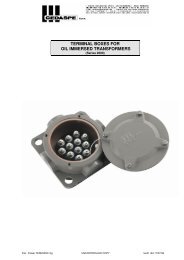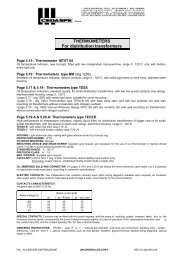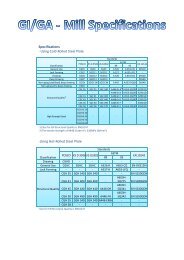gas actuated relays for oil filled transformers en 50216-2 - maxsteel
gas actuated relays for oil filled transformers en 50216-2 - maxsteel
gas actuated relays for oil filled transformers en 50216-2 - maxsteel
You also want an ePaper? Increase the reach of your titles
YUMPU automatically turns print PDFs into web optimized ePapers that Google loves.
9. Installation9.1 MountingThe <strong>gas</strong> <strong>actuated</strong> relay is mounted on the connecting pipe betwe<strong>en</strong> thetrans<strong>for</strong>mer and the conservator.The pipe has to allow the easy flow to the relay of the <strong>gas</strong> arising from faultsinside the trans<strong>for</strong>mer, starting from the highest point on the trans<strong>for</strong>mer coverand must not protrude inside into the trans<strong>for</strong>mer.The pipe should not contain any right-angle elbows. Its diameter shouldcorrespond to the diameter of the hole <strong>for</strong> the passage of <strong>oil</strong> of the relay.The pipe must be arranged to slope upwards towards the conservator at anangle of about 2 to 4 degrees to the horizontal (max 5 degrees).The part of the pipe preceding the relay should be straight <strong>for</strong> a l<strong>en</strong>gth equal toat least five pipe diameters; the part of the pipe leading to the conservatorimmediately adjac<strong>en</strong>t to the relay should be straight <strong>for</strong> a l<strong>en</strong>gth equal to atleast three pipe diameters.A flat surface on the cap of the relay make it possible, using a spirit level, tomount the relay with the proper inclinationThe petcock at the top of the relay must be at a level below the bottom of theconservator.Wh<strong>en</strong> mounting, the arrow <strong>en</strong>graved on the body of the relay must point in thesame direction as the <strong>oil</strong> flow to the conservator.If the trans<strong>for</strong>mer is provided with an explosion v<strong>en</strong>t or similar attachm<strong>en</strong>t, thismust be sealed in such a way that any <strong>gas</strong> liberated by the trans<strong>for</strong>mer doesnot accumulate in the v<strong>en</strong>t, otherwise the operation of the alarm float will bedelayed.9.2 Setting to workOnce the relay has be<strong>en</strong> mounted, unscrew the knurled cap which covers thepush-button <strong>for</strong> checking the circuits and remove from inside it the smallspacer which immobilises the alarm and tripping floats in their lower position,thereby prev<strong>en</strong>ting their movem<strong>en</strong>t during despatch.Op<strong>en</strong> up the <strong>gas</strong> release cock, located on the relay cover, to allow the relay tofill up with <strong>oil</strong>.The filling up and the position of the floats can be se<strong>en</strong> through the inspectionwindows.Wh<strong>en</strong> the relay is <strong>filled</strong> with <strong>oil</strong>, close the <strong>gas</strong> release cock.The electrical circuits must be connected as shown in the diagramaccompanying the relay.9.3 Maint<strong>en</strong>anceThe buchholz relay does not need periodic maint<strong>en</strong>ance; however it isadvisable to check regularly the electric contact and the freely movem<strong>en</strong>t offloat.Nome file : RELE EN<strong>50216</strong> REV 04 DTD 23/04/2007 Pagina 6 di 22UNCONTROLLED COPY







